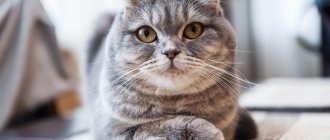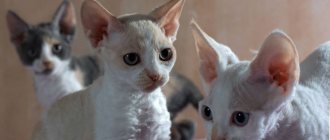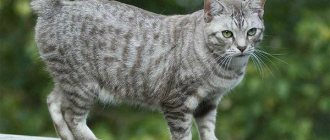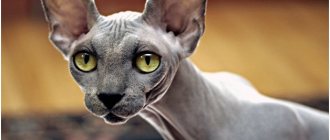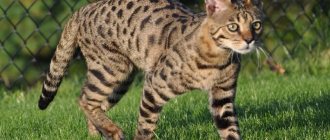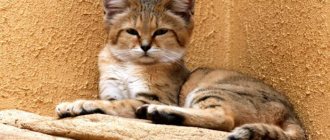Burmese cats (Burmese) are affectionate, friendly animals, distinguished by a well-built, strong body and short, glossy hair. Their good nature extends not only to the owner, but also to other pets living in the house. It is the gentle nature that leads to the growing popularity of this breed. In the article we will tell you everything about the Burmese breed, how much these chocolate cats cost, as well as how to choose the right kitten and raise it to be an exemplary representative of the breed.
Origin story
But some experts are confident that the Burmese cat originated in 1934 in America. Dr. Joseph Thompson, from a trip to Asia, brought a cat named Wong Mau to San Francisco. She had an unusual reddish-brown color and soft fur. When she was crossed with a Siamese cat, the cutest kittens were born with the distinctive breed characteristics of modern representatives of the Burmese breed.
Currently, the breed is classified by several standards:
- according to FIFe – III category – shorthair & Somali – BUR standard;
- according to WCF – III category – Shorthair – IGK standard;
- according to CFA – category SH – Shorthair – Burmese standard.
According to classifications, Burmese cats have distinctive breed features and generally accepted characteristics.
Training
Most cats have high intelligence, but Burmese cats are leaders in terms of development.
They can even be taught simple commands to “sit”, “lie down” and fetch things.
- For proper execution of commands, the cat should be encouraged with a tasty treat.
- When training, it is important to have patience and not shout at the animal, otherwise this threatens the owner with a complete refusal to carry out commands.
- Representatives of this breed can be easily litter box trained and will not cause any trouble.
Characteristics of the Burmese breed
It is almost impossible to confuse a pet of this breed with others. After all, they have individual characteristics inherent only to representatives of the Burmese. To gain an idea of these animals, you need to read their descriptions.
Standard
Cats brought from Asia, when crossed with the Siamese breed, produced unique offspring, which were later identified as a separate breed and characterized by certain standards. There are American and European types of Burmese breed.
The reference standards, regardless of the type of breed, are as follows:
- Body: strong, well-built, muscular; size medium; have a gender difference - cats grow larger than cats; the chest is wide, rounded; the back is straight; weight is quite large for the size: 3-6 kg for females and 5-9 kg for males;
- Coat: short, smooth, thick, without undercoat (no striped pattern).
- Head: pronounced profile, with a transition from the forehead to the nose; strong chin, correct bite; the neck is well developed, wide, short; cheekbones are wide.
- Eyes: large, clearly outlined, greenish or yellow in color; the distance between the eyes is large (blue eyes and squint are considered a defect).
- Ears: regular triangular shape; slightly rounded tips; the nose is short.
- Limbs: proportional, medium in size, paws are low, have powerful muscles, paws are round in shape, have 5 toes on the forelimbs and 4 on the hind limbs; the tail is long and fluffy.
- Life expectancy: 12-17 years.
Differences between American and European Burmese
The American type has a rounded head, rounded ear tips, and huge round eyes, most often green.
The European type is distinguished by a pronounced wedge-shaped head and large, predominantly yellow eyes with straightened eyelids (eastern cut). The peculiarity of the eye shape of Europeans makes their gaze outwardly more focused and serious, in contrast to the open gaze of the American Burmese.
Photos of colors
The Burmese color standard is determined based on which direction it belongs to: American or European. It is immediately worth noting that the color of the European Burmese includes all the color options of the American standard fur.
American standard colors:
- black (sable)
- blue
- lilac (platinum)
- coffee with milk, chocolate (champagne in the USA)
Colors unique to the European Burmese:
- red (also called Burgundy)
- tortoiseshell
- cream
Health
In general, the cat’s health can be described as strong, their immunity is strong, but there are some points that are worth paying attention to:
- teeth - there is a risk of gingivitis , so regular dental examinations by a veterinarian are necessary;
- The condition of the respiratory tract of this breed needs to be given special attention - Burmese cats often suffer from lacrimation, colds, and runny nose ;
- there is a tendency to complete or partial blindness ;
- hypokalemia (low potassium levels in the blood);
- congenital deformation of the skull in kittens is possible
- tendency to diabetes.
Among other things, Burmese require regular vaccination and anthelmintic prophylaxis.
Character
Pets of this breed have a truly angelic character, they have such features as:
- calm;
- sociability;
- attachment;
- friendliness;
- not conflict.
Despite the fact that cats usually do not get along well with each other, Burmese cats are friendly towards new family members. But most of all, Burmese cats adore their owner . They depend on his opinion and mood. These pets also easily find a common language with children . There have never been any cases of aggression or revenge from these beautiful animals. And, in general, purrs of this breed are not distinguished by excessive activity and playfulness .
A rather unusual phenomenon for the cat family is that Burmese cats are easy to train . They do not create problems for their owner either in everyday life or in behavior.
The gentle temperament of Burmese cats captivates and persuades you to choose this particular breed. In addition, these animals have an innate cleanliness, which adds another advantage to them.
Health and diseases
Representatives of this breed are in good health, but may suffer from hereditary diseases.
In addition, they may experience:
- Difficulty breathing.
- Copious secretion of tear fluid.
- Curvature of the skull.
- Tail deformity.
You need to remember to constantly visit the veterinarian and vaccinate the animal, even if the animal is constantly at home. There should be an anthelmintic agent at home.
Possible problems
There are no special breed problems or restrictions in keeping these cats, but still some points can negatively affect the health and behavior of the pet:
- Although the hair of Burmese cats is not long and is not subject to heavy shedding, it requires constant care and combing. Therefore, those who are not ready to pay attention to their pet and brush it at least once a week with a special brush should not get a Burmese cat.
- Another reason to think about purchasing a kitten is frequent trips and business trips . Representatives of the Burmese breed are strongly attached to their owner, so you should not leave your pet alone for a long time.
- A cold climate will be a serious inconvenience for a Burmese cat . Due to the structure of the skull and short nose, the cat is susceptible to frequent colds and runny noses, and frosty weather will only worsen the situation. Such conditions are unacceptable for the health of the pet.
Interesting video about the characteristics of the breed:
Behavior and temperament
The character of a short-haired Burmese cat can be characterized by several qualities, the main ones of which are devotion, docile and unobtrusive behavior, which is due to congenital, genetic components. The breed is friendly and playful, but at the same time, such pets are distinguished by increased sensitivity, as well as incredible tact in relation not only to the owner, but also to all family members.
This is interesting! The Burmese gets along well with children of different ages; the breed is quite loyal to dogs and other cats, but can look down on them, which is due to the royal origin inherent in the genetic level.
The Burmese cat is simply organically unable to tolerate loneliness or too long separation from its owner, so most often its owners are elderly people, as well as people who are not too busy with work. Burmese are naturally gifted with a high level of intelligence and good communication skills. A very affectionate and sociable pet at the same time has a strong and strong-willed character, so such a pet is not capable of doing anything that it does not like at all. In this case, even a not too old Burmese pet can show truly incredible stubbornness.
Return to content
Care
Burmese breeds are not particularly demanding in terms of care; it is enough to satisfy some basic needs of the animal.
Wool
The coat of a Burmese cat is special and requires attention and care. The wool is soft, comparable to mink, and has no undercoat . They are also called “silk bricks” because of their exquisite coating and considerable weight. To preserve the beauty given by nature, you need to comb the animal at least once a week with a special glove or brush. On its own, the Burmese Shorthair practically does not shed , which allows it to be kept even by allergy sufferers (only if the allergy is not to cat saliva and skin particles).
You should bathe your pet no more than once every 5 months. The only exception would be severe pollution or going to an exhibition. If the owner does not have the opportunity to care for the cat on his own, then you can contact veterinary offices that provide grooming services - caring for the appearance of pets.
Nutrition
The nutrition of Burmese cats does not differ from generally accepted standards of care, since they are not prone to allergic reactions and digestive problems. There are two options for feeding Burmese cats: homemade and store-bought food. With the right approach, both methods will be acceptable. To better understand, you need to consider each method separately.
Homemade food , of course, will have a positive effect on the pet’s well-being, but a considerable amount of time is devoted to this method. of raw defrosted meat per day , which is about 80% of the diet . The meat should be lean, preferably lamb, rabbit, beef, and poultry. To make it convenient for the cat to eat, you need to cut it into small pieces of 1x1 cm.
Vegetables and herbs are served with meat , but some Burmese cats refuse such an addition and independently look for healthy herbs in the clearing or garden. Dairy products also make up a large share of the diet: cottage cheese, yogurt, fermented baked milk . a hard-boiled egg twice a week fish meat once . The bones must be removed first.
Dry food or canned food can now be found in any veterinary store. But his choice should be approached responsibly. The main proportion of the feed composition should be animal proteins . To a lesser extent, proteins of plant origin, fiber, vitamins, and microelements are present. Good food does not require additional investment in nutritional supplements. We have prepared a rating of the best wet food, which you can see in our article.
Important! Under no circumstances should you feed your pet both store-bought food and homemade food at the same time. They are poisoned differently, so together they disrupt the digestive process.
Caring for ears, eyes and other body parts
Because Burmese cats are prone to colds and watery eyes, you need to pay attention to caring for their eyes. As with other breeds, proper weekly cleaning of the eyes and ears with a cotton swab dipped in a special solution is important. If you notice moisture near the nose and eyes, it is important to promptly wipe them with veterinary products. If the discharge does not stop, the animal must be taken to the veterinarian immediately.
These cats rarely produce claws, so there is no particular need to cut them off often. Burmese cats treat furniture with the same respect - they do not like to tear or tear it off. We can conclude that for aesthetic purposes it will be enough to cut off the claws once every 1-2 months .
Important! Cats need to have their claws trimmed correctly! In no case should this be done at the root, but only by removing the sharp ends. In addition, cutting the claw lengthwise, like a human, will cause suffering to the poor animal. You need to cut across the wide side.
Walking your pet
Since Burmese cats have a calm disposition, they are kept both in a private house and in an apartment. But in any case, free range is not the best solution. It would be ideal to accompany your pet on a walk. Because of its curiosity, the Burmese cat will try to get acquainted with all the nooks and crannies, so it would be a good idea to purchase a special leash.
Keeping Burmese at home
Interesting to know! It is believed, according to ancient beliefs, that Burmese cats bring good luck to the house. That is why they were kept in temples, as well as in the abodes of rich people, who believed that these cats contributed to the appearance of wealth, prosperity and family happiness in their home.
In fact, such legends have nothing to do with the behavior of this cat, since they themselves represent an ideal animal for keeping at home. These are friendly and fairly clean pets. At the same time, they have a hard time experiencing long-term separation, remaining alone, and this factor must be taken into account.
Due to the fact that Burmese cats are quite curious by nature, it is necessary to ensure that they do not have access to various things and household items, especially at a young age. The same applies to household chemicals that cats can taste.
It is not recommended to let this cat go for a walk on its own. It is very important that she is on a leash. You can let her out at your dacha, but it is better to always remember that the cat is vaccinated and also take care of other means of protection, such as a flea collar, for example.
Care and hygiene
These cats do not require special care, especially since they have short hair without undercoat. The coat is combed once every 2 weeks and this is quite enough. You should also not bathe your animal frequently. It is enough to organize water procedures a couple of times a year.
As a rule, they tolerate water procedures without problems, since they completely trust their owner. The eyes and ears of your pet should be cleaned once a month, and the nails should be shortened once every 2 months.
What to feed
When feeding ready-made dry factory mixtures, preference should be given to premium or super-premium food. This is necessary to ensure that the cat receives all the necessary nutritional components, which is so important for the health of a domestic cat. When feeding kittens, care must be taken to include low-fat boiled fish in their diet. To effectively fight tartar, you need to make sure that dry food is present in your diet.
It is better to give older cats natural food, including rabbit meat, chicken or beef, but in the form of minced meat, since old animals have great difficulty chewing solid food. Pregnant or lactating cats require increased nutrition. To do this, it is enough to increase the daily ration or use special purchased feed. Nowadays, you can buy any food for animals in specialized stores.
Important to remember! Your pet should not be allowed to overeat. These are large animals with a good appetite that can eat more food than they should. In this regard, it should be noted that this breed is prone to gaining excess weight, and this can lead to health problems.
Under no circumstances should cats be given food from the human table. People tend to eat salty, spicy or sweet foods, which are harmful to pets, including cats, regardless of breed.
5 features of keeping a Burmese
Diseases, breed defects
These cats are susceptible to extremely unpleasant diseases, and this is true both in relation to the European Burmese cat and in relation to the American one. This is one of the negative factors that scares away many who want to have a Burmese cat at home. Therefore, when choosing a kitten, it is very important not to make a mistake.
Gangliosidosis is considered one of the most common hereditary diseases of the nervous system. The disease begins to manifest itself from an early age in the form of lameness and paralysis. As a rule, the pet dies because this disease cannot be treated, despite the enormous efforts of modern scientists who are trying to solve this problem.
Hypokalemia, which is associated with a lack of potassium in the animal’s body. A deficiency of this component leads to increased fatigue, as well as general lethargy. The disease can be treated by administering drugs containing potassium ions. Otherwise, the process worsens and paralysis of the animal occurs.
Burmese cats may develop flat chest syndrome, which can be detected in the first days of a kitten's life. This disease is associated with imbalance of the chest muscles, which leads to disability of the animal. There is no effective treatment for this disease, although some kittens manage to survive this disease, after which everything returns to normal.
The eyes, ears and mouth are also considered areas that are prone to various abnormalities. In any case, you should seek help from a veterinarian, since only specialists can prescribe the correct treatment.
Important point! Veterinarians have all the necessary information, as well as medications that will help solve various health problems for pets.
Pet card
| Characteristics of a cat | Notes | |
| General information | Adorable kittens grow into very affectionate cats | There are different colors |
| Character | A very talkative cat. Affectionate, loves to participate in family life, requires attention | |
| Appearance | European and North American Burmese are different from each other | At American shows, European Burmese are considered a separate breed. |
| Behavior at home | Extroverts, playful by nature. They don't like it when people don't pay attention to them | They love to climb, play, and chase toys. |
| Care | Minimal care. Stroking and wiping with a suede cloth promotes shine in the coat. | |
| Health problems | Sometimes there is protrusion of the lacrimal gland | Treated surgically |
Difference between American and European Burmese
Burmese is a generic name that includes two varieties of the breed: American and European. Both representatives are incredibly beautiful and graceful. They fascinate with their penetrating panther gaze. But they differ in appearance, as can be seen in the photograph.
On the left is an American Burmese, on the right is a European Burmese
Difference in coat color
The American standard implies 4 colors:
- sable;
- champagne;
- blue;
- lilac.
European representatives can be in the following colors:
- brown;
- lilac;
- scarlet;
- chocolate;
- blue;
- cream;
- tortoiseshell: with a cream, blue, chocolate or lilac tint.
Differences in the eyes
The American class of Burmese have large and round eyes, far apart. Therefore, these creatures always look childishly touching.
Krgulye
“Europeans” have equally large eyes at a considerable distance from each other, the upper eyelid slopes toward the line of the nose, and the lower eyelid is slightly rounded. They have a sullen look, giving the cat a stern look - this is their distinctive feature.
Severe
Ears
American Burmese have small ears, wide at the base and rounded at the ends. They are wider apart than those of European representatives. The latter's ears are set quite low and tilted forward. Set wide. They are larger in size than the “Americans”. The outer edge of the ears is in line with the cheeks.
According to the shape of the head
American individuals differ in head shape from European ones by being more rounded and fuller in all forms. Euroburms have a wedge-shaped, blunted skull with a slight rounding between the ears.
In the face
The muzzle of the American Burmese is round with large, surprised eyes. The European breed has a triangular-shaped muzzle and a stern look due to slightly drooping upper eyelids. They also have a very prominent chin.
Body type
European Burmese differ from American Burmese in that they are not so heavy-boned. In general, representatives of both types can boast of sophistication, elegance and sophistication. At the same time, they have a well-developed muscular frame.
How to choose a kitten
You need to buy a Burmese kitten after it reaches 2-3 months . At this time, he gains independence and his immunity is strengthened. To choose a real Burmese kitten you need to pay attention to the following factors:
- clear eyes;
- clean ears;
- activity;
- shiny healthy coat;
- fatness;
- pink is the healthy color of the sky;
- absence of unpleasant odor, physical defects, discharge from the eyes and nose.
Otherwise, kittens correspond to the characteristics of adult cats: eye shape, muzzle, body structure. To be sure of the baby’s subglacial breed, you need to familiarize yourself with his documents:
- kitten birth metric;
or
- completed pedigree of the kitten;
- veterinary passport;
- upon purchase, a purchase and sale agreement is drawn up in two copies.
The price of a baby varies from 15 to 35 thousand rubles. How much a Burmese kitten costs is greatly influenced by its pedigree and title of parents. An obviously undervalued price may indicate a kitten illness or
Tips for choosing a kitten
To make a safe purchase, avoid bird markets and free classified ads posted online. Opt for large nurseries with good reviews, ready to confirm the legality of their activities with all the necessary documents. The only disadvantage of such establishments is the high price for furry pupils.
Burmese kittens up to 3 months old are up for sale. If you want to buy a show-class pet, then choose an animal over 1 year old. Until this age, light brown tints in the sable color are acceptable, which interferes with an adequate assessment of the exterior. The final cost of the kitten consists of the costs incurred and compliance with the standard.
When choosing a kitten, consider:
- Appearance of a kitten. Have a preliminary consultation with a felinologist or an experienced breeder. Take a photo with you to make sure the exterior matches, and carefully examine the kitten for possible pathologies. A disheveled appearance, red or watery eyes, an unsteady gait and a bloated tummy are warning signs that indicate a sick animal.
- Parents' appearance. Pictures posted on the Internet do not always correspond to reality. Insist on meeting your parents in person to prevent miscegenation.
- Provided documents. The seller is obliged to provide the buyer with a sales contract and breeding documents confirming the origin of the kitten and its parents. If the kitten is more than 3 months old, then a veterinary passport containing notes on vaccinations is added to the listed documents.
The danger of buying a mixed breed lies not so much in non-compliance with the standard (which is not scary if you did not intend to participate in exhibitions), but in the likelihood of buying an animal with genetic diseases.
Interesting facts about the breed
Burmese cats are the most mysterious cat breed in the world. In their homeland in Burma, these animals were deified; there is even a legend that Burmese cats are the reincarnation of the souls of monks. Nowadays, because of their affection and strong love for their owners, Burmese cats are called “cat-dog” .
Burma loves to “talk”; she can be called the chatterbox of the cat world. So if you are used to silence, then you need to approach the choice of the Burmese breed with all seriousness.
Burmese cat character
The breed character of the Burmese cat basically has only advantages.
The positive qualities of the Burmese include:
- Intelligence. These are smart, quickly learning creatures that easily learn the simplest rules of house behavior. Do not forget to sharpen your claws on the scratching post and will only use a clean tray.
- Loyalty to the owner - the Burmese cat follows the owner everywhere, and the Burmese cat adores the mistress of the house.
- Love for children is a distinctive feature of the Burmese. They will never offend a child, even if he gets too playful and hurts the cat, which will not scratch the baby.
- Playful, active until old age, the Burmese breed will always support any fun with both children and other inhabitants of the house.
Important! The Burmese cat will not cause a negative reaction, redness, lacrimation or runny nose, even among allergy sufferers.
The breed has practically no disadvantages. Irritation and anxiety can be caused by:
- Excessive timidity of the pet. Any sharp knock causes them to run and jump out the window.
- A friendly attitude towards people and the ability to follow them can lead to the loss of a pet.
- The Burmese cat suffers from loneliness and the long absence of its owner becomes stressful for it.
The Burmese is closely related to the Bombay breed
